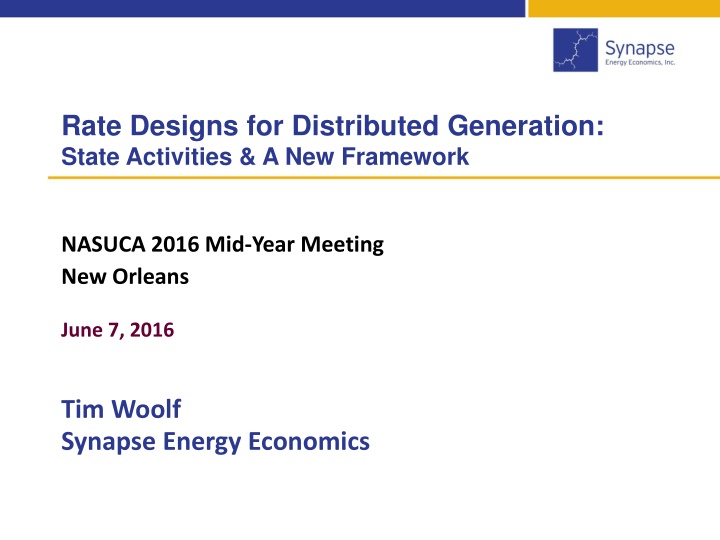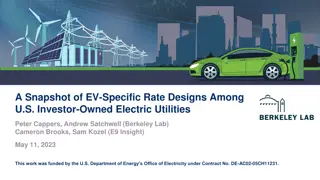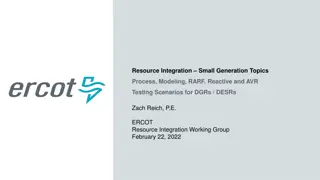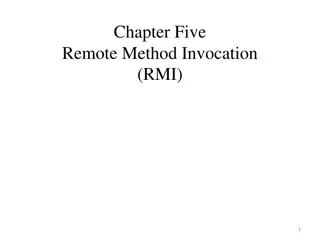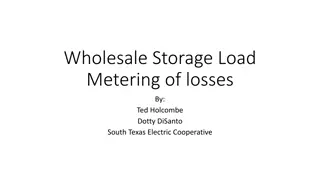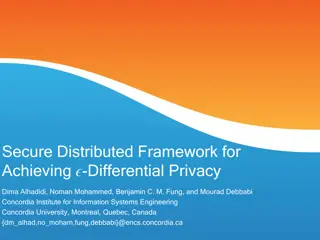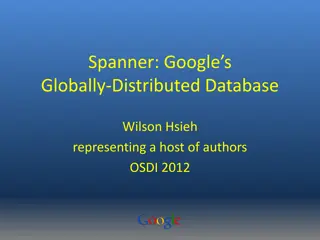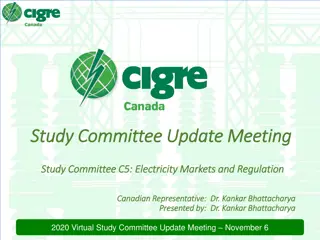Rate Designs for Distributed Generation: State Activities & A New Framework
Explore recent activities in rate designs for distributed generation, including fixed charges and time-varying rates. Learn about residential AMI penetration and case studies. Discover a new framework for assessing DG policies based on comprehensive quantitative analysis.
Download Presentation

Please find below an Image/Link to download the presentation.
The content on the website is provided AS IS for your information and personal use only. It may not be sold, licensed, or shared on other websites without obtaining consent from the author.If you encounter any issues during the download, it is possible that the publisher has removed the file from their server.
You are allowed to download the files provided on this website for personal or commercial use, subject to the condition that they are used lawfully. All files are the property of their respective owners.
The content on the website is provided AS IS for your information and personal use only. It may not be sold, licensed, or shared on other websites without obtaining consent from the author.
E N D
Presentation Transcript
Rate Designs for Distributed Generation: State Activities & A New Framework NASUCA 2016 Mid-Year Meeting New Orleans June 7, 2016 Tim Woolf Synapse Energy Economics
Outline Part 1: Overview of recent related activities Fixed charges Time-varying rates AMI penetration Solar NEM penetration Two case studies Part 2: A new framework for assessing DG policies Comprehensive Quantitative Tim Woolf Synapse Energy Economics Slide 2
Recent Fixed Charge Decisions $60 Denied Charge Approved Charge $50 Existing Charge $40 $30 $20 $10 $0 Consumers Energy (MI) Salt River Project (AZ) Wisconsin Public Service (MI) Maui Electric Company (HI) Central Maine Power Company (ME) Baltimore Gas and Electric (MD) Madison Gas and Electric (WI) Black Hills Power (WY) Kentucky Utilities Company (KY) Metropolitan Edison (PA) Pennsylvania Power (PA) Hawaii Electric Company (HI) We Energies (WI) PacifiCorp (WA) Northern States Power Company (ND) Empire District Electric (MO) Redding Electric Utility (CA) Appalachian Power/Wheeling Power (WV) Rocky Mountain Power (UT) Ameren (MO) City of Whitehall (WI) Hawaii Electric Light (HI) Choptank Electric Cooperative (MD) Central Hudson Gas & Electric (NY) Independence Power & Light Co (MO) Kentucky Power (KY) Xcel Energy (MN) Sierra Pacific Power (NV) Nevada Power Co. (NV) Eugene Water & Electric Board (OR) West Penn Power (PA) Alameda Municipal Power (CA) Consolidated Edison (NY) Connecticut Light & Power (CT) Dawson Public Power (NE) Pennsylvania Electric (PA) Westar (KS) Wisconsin Public Service (WI) Louisville Gas-Electric (KY) Rocky Mountain Power (WY) Stoughton Utilities (W() Benton PUD (WA) Columbia River PUD (OR) Appalachian Power Co (VA) Kansas City Power & Light (MO) Kansas City Power & Light (KS) Indiana Michigan Power (MI) Colorado Springs Utilities (CO) Synapse (2016) Caught in a Fix Slide 3
Penetration of Residential Customers on Time Varying Rates Source: U.S. Energy Information Administration as of January 2015 Slide 4
Residential AMI Penetration Residential AMI Meters as % of Total Residential Meters 100% 90% 80% 70% 60% 50% 40% 30% 20% 10% 0% WI WY WA WV AZ TX LA FL NM NV VT CA AL DE PA SD KS TN AR KY VA SC CO NE AK NY MS DC MD OR NC ND NH OH MT MN CT UT NJ ME GA OK MO IA HI MA RI ID IN MI IL Source: US Energy Information Administration as of January 2015 Slide 5
Solar Net Energy Metering Penetration Source: US Energy Information Administration as of January 2015 Slide 6
Proposed or Enacted Changes to Net Metering Policies in 2015 Source: NC Clean Energy The 50 States of Solar Slide 7
Rate Design Case Studies National Grid in Massachusetts On-going rate case Utility proposed a tiered customer charge Rationale: equity, cost recovery, price signals, DG Acts as a poorly designed demand charge Every intervenor has opposed it Public Service Company of Colorado On going rate case Utility proposed a tiered customer charge Rationale: equity, cost recovery, price signals, DG Acts as a poorly designed demand charge Tim Woolf Synapse Energy Economics Slide 8
Framework for Assessing Rate Designs & DG Policies Forthcoming Report: Synapse Energy Economics, Show Me the Numbers: A framework for assessing distributed generation policies, prepared for Consumers Union, November, 2016 Many DG policy discussions are piecemeal Few DG policy discussions are informed by quantitative analyses on the key issues: Cost-effectiveness Cost-shifting DG development Framework to comprehensively assess issues quantitatively Tim Woolf Synapse Energy Economics Slide 9
Related Ratemaking Elements Cost of Service Studies Resource Planning Rate Design Goal: cost allocation. Costs: based on embedded (historical) costs. Connection: Used as input to rate design. But does not dictate rate design. Goals: revenue recovery, equity, efficient price signals. Costs: addresses both historical and future (net) costs. Connection: Price signals influence customer DER decisions. Goals: to provide low-cost, reliable, safe, electric services. Costs: based on future (net) costs. Connection: Will be influenced by customer DER decisions. Tim Woolf Synapse Energy Economics Slide 10
1. Cost-Effectiveness The cost-effectiveness tests used for energy efficiency: Often used to assess PV cost-effectiveness Should be used thoughtfully Utility Cost: Impacts on utility revenue requirements Total Resource Cost: Impacts on host customer and utility Societal Cost: Impacts on society (value of solar) Rate Impact Measure: Implications for cost-shifting Participant Cost: Implications for DG development Tim Woolf Synapse Energy Economics Slide 11
2. Cost-Shifting Cost-shifting is one of the most important issues in determining DG policies, and should be analyzed fully. The RIM test does not provide meaningful information It is too simplistic The lost revenues from DG should not be simply added to the costs of DG they are a sunk cost A rate impact analysis should be used instead A long-term estimate of how rates will be affected by DG Including all the costs and benefits that affect rates Accounting for the impacts of lost revenues on rates Implications Lost revenues create upward pressure on rates Avoided costs create downward pressure on rates The net effect provides an indication of cost-shifting Tim Woolf Synapse Energy Economics Slide 12
3. DG Development The development of DG resources is one of the key goals of DG policies, and should be explicitly modeled There are relatively straight-forward methods Payback periods Customer adoption rates Will depend upon rate design and other DG policies Scenarios based upon different policies Nevada example. Residential customer payback period: under historical rate design: 11 years under NVE proposed rate design: 21 years Tim Woolf Synapse Energy Economics Slide 13
A Framework to Assess Policy Options Illustrative Example: 2. Rate Impacts 1. Cost-Effectiveness 3. DG Development Policy Options: Utility Net Benefits (PVRR ) Societal Net Benefits Customer Payback (years) DG TRC Net Benefits (Long-Term Average) Penetration (10 years) 1. NEM: conventional $120 $24 $60 0.8% 10 12% 2. NEM: with reduced payment for excess $60 $12 $30 0.6% 14 8% 3. NEM: plus increased fixed charges $12 $2 $6 0.0% 20 2% This information can be used to balance the goals of: allowing sustainable development of distributed PV, and protecting customers. Slide 14
Contact Information Tim Woolf Vice President Synapse Energy Economics 617-453-7031 twoolf@synapse-energy.com www.synapse.energy.com Tim Woolf Synapse Energy Economics Slide 15
